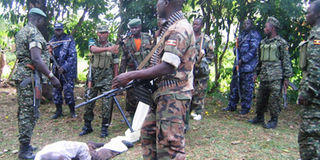Promote unity among cultural groups

What you need to know:
Mistakenly, government thinks it can install, undermine or promote certain tribal groups without encountering significant opposition from within society
The root causes of Bundibugyo-Kasese-Ntoroko ethnic clashes squarely lie with government’s failure to justly respond to Uganda’s heterogeneous social and cultural reality. The creation of irrelevant tribal districts, sub-division of our diversity and over politicisation of decentralisation policy have produced a fragmented society. This has set our country on a time bomb.
In my opinion, these clashes cannot be dismissed as merely tribal clashes but rather, the vicious ethnic loyalty represents a social identity that people have violently turned to in an attempt to define themselves in the struggle against policy errors and threats to lose their land.
Since the promulgation of the 1995 Constitution that guarantees a right to culture, there has been detrimental politically instigated attempts to marginalise and exclude some regions, groups or individuals while favouring others. In doing so, government often encountered resistance, such as strikes and demonstrations although sometimes it was pragmatic enough to make concessions and maintain the statuesque.
Like the case of Kayunga riots in Buganda Kingdom that erupted in 2009 after the prime minister of Buganda, Mr J.B Walusimbi, was blocked from visiting this area, installing the Bamba King, the Omundhingiya, Lt Col Martin Kamya, was a fundamental mistake. There was probably no attempt at consultation with affected the groups and no genuine effort to accommodate their interests or obtain their consent. Although I am not apportioning blame but this might not have gone well with the radical elements within the Obusinga bwa Rwenzururu, a cultural institution of the Bakonzo. Perhaps President Museveni’s presence at the coronation was too much for some sections to accept.
This has been preceded and aided by contributing factors such as poverty, access to weapons, linkages to ADF and the remoteness of the region in organising resistance. How can one explain the attack on a police station, military barracks, a bank and Resident Commissioner’s home?
Similarly, the region’s economic decline has worsened the governance problems. Although the government has been able to extract substantial economic resources from this region, it has ironically spent those resources primarily on a small ruling clique of cadres, while failing to deliver basic services or foster economic development to the majority.
There is a widening gap between government and society. Mistakenly, government thinks it can install, undermine or promote certain tribal groups without encountering significant opposition from within society. The lessons from the Kayunga riots, Busoga fights and now the Rwenzori sub-region show that in many regions across the country there are sources of opposition with a strong indigenous base including factions with political, ethnic or clan origins. A prudent government should take care to build consensus among key elements in society.
[email protected]




